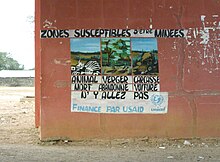| Casamance conflict | |||||||
|---|---|---|---|---|---|---|---|
 Painting in Oussouye warning of land mines in the area. | |||||||
| |||||||
| Belligerents | |||||||
|
|
Supported by: | ||||||
| Commanders and leaders | |||||||
|
|
| ||||||
| Strength | |||||||
|
|
300–600 (1989)[8] 2,000–4,000 (2004)[9] 180 (2006) | ||||||
| Casualties and losses | |||||||
|
5,000 killed in total since 1982[10] 60,000 internally displaced[11] | |||||||
The Casamance conflict is an ongoing low-level conflict that has been waged between the Government of Senegal and the Movement of Democratic Forces of Casamance (MFDC) since 1982. On May 1, 2014, the leader of the MFDC sued for peace and declared a unilateral ceasefire.
The MFDC has called for the independence of the Casamance region, whose population is religiously and ethnically distinct from the rest of Senegal.[12] The bloodiest years of the conflict were during the 1992–2001 period and resulted in over a thousand battle related deaths.[12]
On December 30, 2004, an agreement was reached between the MFDC and the government which promised to provide the voluntary integration of MFDC fighters into the country's paramilitary forces, economic recovery programmes for Casamance, de-mining and aid to returning refugees.[12] Nevertheless, some hard-line factions of the MFDC soon defected from elements of the MFDC who had signed the agreement and no negotiations took place following the breakdown of talks in Foundiougne on 2 February 2005.[12]
Fighting again emerged in 2010 and 2011 but waned following the April 2012 election of Macky Sall. Peace negotiations under the auspices of Saint Egidio community took place in Rome and on 14 December 2012, President Sall announced that Casamance would be a test-case for advanced decentralization policy.[12]
- ^ Minahan 2002, pp. 400–401.
- ^ a b "Senegal says troops overrun rebel camps in Casamance region". Africa News. AFP. 10 February 2021. Archived from the original on 11 February 2021. Retrieved 12 February 2021.
- ^ a b c d e f g Andrew McGregor (21 February 2021). "Is the Curtain Dropping on Africa's Oldest Conflict? Senegal's Offensive in the Casamance". Aberfoyle International Security. Archived from the original on 4 September 2021. Retrieved 4 September 2021.
- ^ a b c d e Christophe Châtelot (19 June 2012). "Boundaries of Casamance remain blurred after 30 years of conflict". The Guardian. Archived from the original on 14 December 2017. Retrieved 14 December 2017.
- ^ Minahan 2002, pp. 400, 401.
- ^ a b Minahan 2002, p. 400.
- ^ "Senegal: Movement for the Democratic Forces of Casamance (MFDC) rebels declare unilateral truce » Wars in the World". Warsintheworld.com. Archived from the original on 28 September 2017. Retrieved 12 October 2014.
- ^ Cite error: The named reference
Lambertwas invoked but never defined (see the help page). - ^ Williams 2016, Casamance.
- ^ "Casamance: no peace after thirty years of war - GuinGuinBali.com". Guinguinbali.com. Archived from the original on 3 January 2013.
- ^ Harsch, Ernest (April 2005). "Peace pact raises hope in Senegal". Archived from the original on 2017-09-06. Retrieved 2017-06-28.
- ^ a b c d e "Database - Uppsala Conflict Data Program (UCDP)". Ucdp.uu.se. Archived from the original on 2017-10-01. Retrieved 2016-11-02.[verification needed]